Essential Strategies for Thriving in Mountainous Heat: Preparing for High-Temperature Adventures
- gdacook
- Jul 12
- 4 min read
As the UK is gripped by a heatwave, the mountains call to adventurers with their fresh air and stunning views. The thrill of exploring these landscapes is enticing, but the challenges of hot weather should not be overlooked. Proper preparation is key to having a fun and safe experience in high temperatures. ive ocompiled this guide to offer practical strategies to help you navigate sun-soaked mountain adventures effectively.
Understanding Mountain Heat
To prepare for hot weather in the mountains, it’s important to grasp the unique conditions you may face. Mountain weather is often unpredictable, varying dramatically depending on elevation, location, and time of day. For instance, daytime temperatures can exceed 29°C, while nighttime temperatures may drop to 4°C or lower. Such fluctuations can catch even the most experienced adventurers off guard.
Understanding the weather forecast is essential. High altitude means stronger sun exposure, heightening the risk of dehydration and sunburn. Always check temperature predictions and weather patterns before embarking on your journey.
Dress for Comfort and Protection
Choosing the right clothing can make all the difference in mountainous heat. Lightweight, breathable fabrics are essential. Materials such as polyester or merino wool are ideal as they wick moisture from your skin.
Consider wearing long sleeves and long pants to protect against sunburn while remaining comfortable. A wide-brimmed hat can shield your face and neck, while high-quality sunglasses protect your eyes from UV rays. For example, wearing a hat with an UPF rating of 50 can block 98% of UV radiation.

Stay Hydrated
Hydration is critical when facing high temperatures in the mountains. The combination of elevation and heat can lead to rapid dehydration. It is recommended to drink an average of half a litre of water every hour during moderate activities. For instance, if you plan to hike for six hours, aim to carry at least three litres of water. But remember thats 3 kgs of additional weight as well.
When planning your hike, identify known water sources along the way. Investing in a lightweight water filtration system or purification tablets can also be wise, especially for longer treks where carrying extra water isn’t feasible.
Plan Your Adventure Wisely
When exploring the mountains during hot weather, timing is crucial. Early mornings and late afternoons typically offer cooler temperatures. For example, temperatures may drop as much as 11°C from midday to late evening, making these hours optimal for hiking.
Plan your hikes to take advantage of these cooler times. Avoid strenuous activities during peak sun hours, usually from 10 AM to 4 PM. Doing so reduces the risk of overheating and enhances your experience as you enjoy the serene beauty of the mountains.
Protect Your Skin
Skin protection is vital in high-altitude sun exposure. whilst we don't need to worry in the UK about extreme elevations its worth knowing that at elevations above 5,000 feet, UV exposure increases by up to 40%. Apply a broad-spectrum sunscreen with an SPF of 30 or higher on exposed skin, reapplying every two hours or sooner if sweating.
Don’t forget areas often neglected, such as your ears, back of the neck, and tops of your feet. Using lip balm with SPF can also protect your lips from harmful UV rays, as they are particularly vulnerable.
Know the Signs of Heat-Related Illness
Recognizing the symptoms of heat-related illnesses is essential for staying safe. Heat exhaustion and heat stroke can develop rapidly if proper precautions aren’t taken. Symptoms to watch for include headache, dizziness, excessive sweating, rapid heartbeat, or feeling confused.
If you or someone in your group shows these symptoms, act quickly. Move to a shaded area if you can, hydrate, and cool down. For severe cases where symptoms do not improve, seeking medical help is imperative.
Embrace Mountain Cuisine
Eating the right foods is just as important as staying hydrated. Opt for nutrient-dense snacks like mixed nuts, dried fruits, and energy bars, which provide sustained energy during your adventures. For example, a handful of almonds can deliver healthy fats and protein, ideal for keeping energy up.
Avoid salty or heavily processed foods, as they can compound dehydration effects. If packing fresh fruits or vegetables like apples, oranges, or celery is feasible, they can add hydration and essential nutrients to your diet.
Utilise Technology and Resources
Take advantage of available technology to enhance your mountain adventure preparation. Several mobile apps provide real-time weather updates, trail conditions, and safety tips.
Incorporate navigational tools to stay oriented while exploring. Sharing your plans with friends or family increases safety in case of emergencies. A plan coupled with reliable resources helps protect you and your group on your journey.
Getting Ready for Your Next Adventure
Preparations for high-temperature adventures in the mountains are essential for an enjoyable experience. By understanding mountain conditions, dressing smartly, staying hydrated, and recognizing signs of heat-related issues, you can ensure safety and enjoyment.
Embrace the magnificent landscapes, savor the fresh air, and make unforgettable memories as you explore the mountains. With these practical strategies, you are now primed to thrive in hot weather and fully immerse yourself in your mountain adventures.




Comments